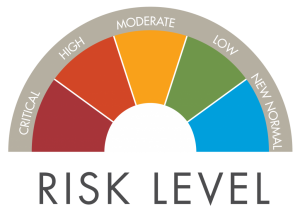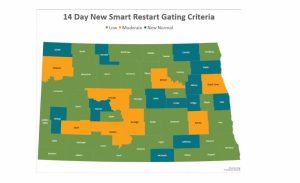 Bismarck (CSi)– Gov. Doug Burgum Thursday announced changes to the COVID-19 risk levels for 21 of North Dakota’s 53 counties under the ND Smart Restart plan, stressing the need to reverse the state’s upward trend of active coronavirus cases and positive test rate.
Bismarck (CSi)– Gov. Doug Burgum Thursday announced changes to the COVID-19 risk levels for 21 of North Dakota’s 53 counties under the ND Smart Restart plan, stressing the need to reverse the state’s upward trend of active coronavirus cases and positive test rate.
Eight counties – Barnes, Benson, Burleigh, Grand Forks, McLean, Morton, Stark and Williams – are moving from the low risk level (green) to the moderate risk level (yellow) under the ND Smart Restart color-coded health guidance. These counties currently account for 64 percent of North Dakota’s 2,437 active cases, Burgum noted.
Stutsman County remains in the low risk (green) risk level.
The goal of moving counties to moderate risk is twofold, Burgum said: to decrease transmissible moments, giving the virus less opportunities to spread, and to raise awareness and communicate to North Dakotans that an elevated risk level exists and there are simple steps they can take to slow the spread, namely:
- Avoid large gatherings and social distance
- Wear masks in public where social distancing isn’t possible
- Wash your hands frequently.
“These are the things that need to happen if we want to keep schools open, if we want to keep businesses open and back to operating at 100%, and most importantly, if we want to protect the most vulnerable among us,” Burgum said. “Let’s remember that our students have given up a lot – missed classes, canceled sports and graduations – and so have our long-term care residents in terms of lost visits with their loved ones. The goal all along has been to protect the most vulnerable and keep things open – to save lives and livelihoods – and we need everyone to be in the fight and be responsible. We truly are in this together.”
 Thirteen counties are moving from the low risk level to the “new normal,” or blue risk level: Billings, Cavalier, Divide, Foster, Griggs, LaMoure, Mercer, McIntosh, Nelson, Renville, Traill, Walsh and Wells. Burgum urged residents in those counties not to become complacent, noting the additional risk inherent with students returning to school and creating more transmissible moments for the coronavirus.
Thirteen counties are moving from the low risk level to the “new normal,” or blue risk level: Billings, Cavalier, Divide, Foster, Griggs, LaMoure, Mercer, McIntosh, Nelson, Renville, Traill, Walsh and Wells. Burgum urged residents in those counties not to become complacent, noting the additional risk inherent with students returning to school and creating more transmissible moments for the coronavirus.
The changes in risk level were based on three main criteria: 14-day rolling average of active cases per 10,000 people, 14-day rolling average of tests performed per 10,000 people and 14-day rolling average percent positive rate.
The county-by-county risk levels will take effect at 5 p.m. Friday, Sept. 4. For those moving from low risk to moderate risk, the recommendation for capacity in bars and restaurants decreases from 75 percent to 50 percent and the recommendation for large gatherings would decrease from 75 percent occupancy up to 500 attendees, to 50 percent occupancy up to 250 attendees.
Despite a recent surge in active cases, because of its robust testing program, North Dakota’s test positivity rate remained under 5% until this week, when the White House’s weekly report to states classified North Dakota as being in the “yellow zone” for test positivity at over 5%, which is consistent with data tracked by the state. Thursday’s action aligns with the White House’s recommendation to adjust the state coronavirus risk level for highly affected counties to reflect persistently high and increasing reported cases.
While the state’s COVID-19 hospitalizations remain relatively low at 67 today, Burgum stressed that hospitalizations are a lagging indicator, not a leading indicator. Southern states that experienced surges in cases among 15- to 29-year-olds earlier this summer, as North Dakota is seeing now, saw those surges followed by increases in the older adult populations, increased hospitalizations and mortality rates, he noted.
“We said we’re going to be targeted and we’re going to be proactive. We’re doing both of those things today,” Burgum said.
The governor urged college students to make use of available COVID-19 testing and to stay on campus or in their campus communities during the Labor Day weekend to avoid potentially spreading COVID-19 to other areas, as young people are more likely to be asymptomatic and unknowingly transmit the virus.












Comments are closed
Sorry, but you cannot leave a comment for this post.